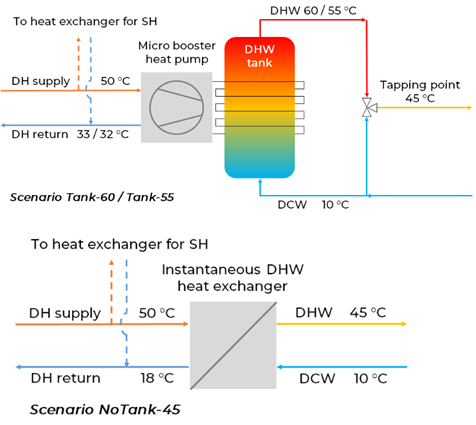This paper presents an analysis of the effect of the temperature and system requirement of Swiss (Tank-60), Danish (Tank-55), and German (NoTank-45) Domestic Hot Water (DHW) regulations on the energy consumption and monetary cost of a 4GDH substation in the Swiss context[1].
The comparison is based on the performance of the different systems when implemented in a case study of a single-family house located in Switzerland with a surface of 150 m2. The building is assumed to be connected to a district heating with a supply temperature of 50 °C.
On the one hand, a simple reduction of 5 °C in the minimum DHW temperature (Tank-55) proved to be effective in reducing the energy consumption and the cost of the system over its lifetime. On the other hand, the NoTank-45 leads to a more affordable solution in terms of investment cost, whereas it has the highest annual cost among the different scenarios. Furthermore, although the DHW energy purchase cost is lower for the NoTank-45 scenario, it is not able to compensate for the fixed expense of the heat tariff, which is much higher due to the larger size of the substation because of the instantaneous DHW production. This result shows the important role of the DHW tank in shaving the consumption peak, thus reducing the rated power of the system.
It can be concluded that a less stringent regulation than the Swiss standard would be beneficial for the further development of 4GDH network, as already enacted in other European countries.
Further reading:
Riccardo Toffanin, Vinicio Curti, Maurizio C. Barbato. Impact of Legionella regulation on a 4th generation district heating substation energy use and cost: the case of a Swiss single-family household. Energy, Volume 228, 2021, 120473, ISSN 0360-5442, https://doi.org/10.1016/j.energy.2021.120473
[1]At the time of writing the paper, the SIA 385/1:2011 standard was in effect. As of February 2022, SIA published the new standard SIA 385/1:2020 with different temperature requirements.

